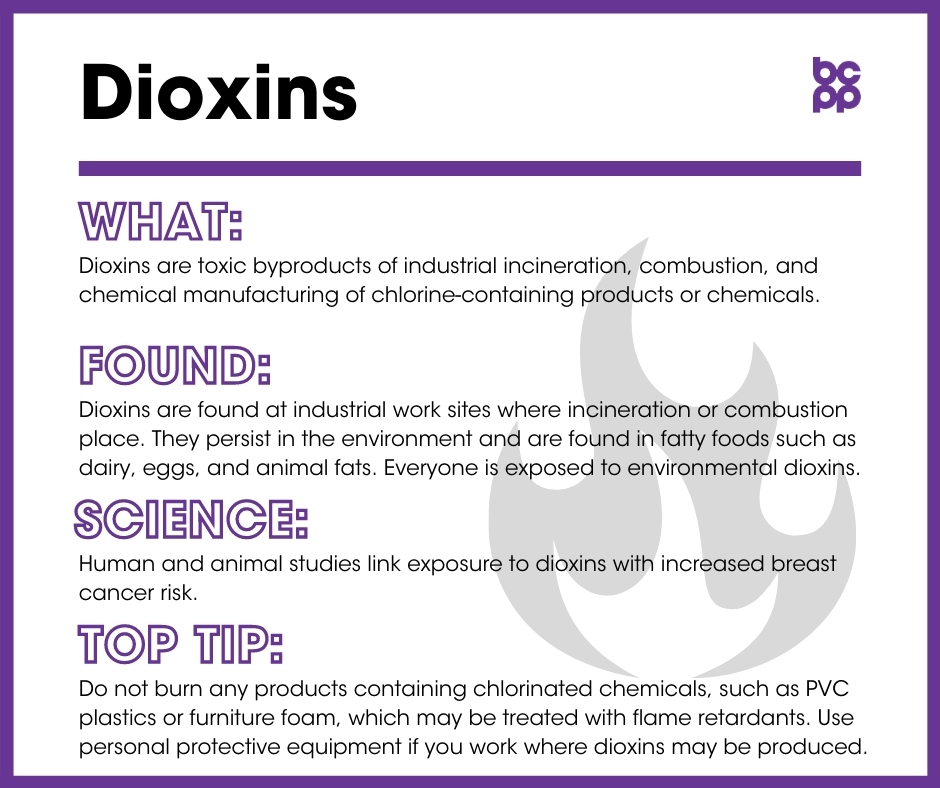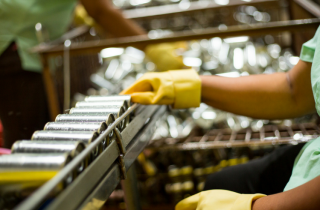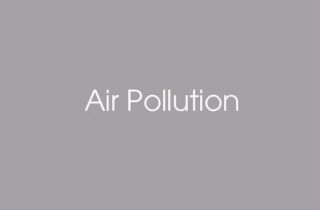Dioxins
What are dioxins?
Dioxins are a group of several compounds that share structural similarities.[1] Dioxins are produced when chlorine-containing products or chemicals are present in certain industrial processes such as incineration and combustion.[2],[3]
Where are dioxins found?
Dioxins are most commonly found at industrial work sites where incineration or combustion may take place.[4] They also persist in the environment and are found in fatty foods such as dairy, eggs and animal fats.[5] Dioxins bioaccumulate and have half-lives varying between six months and 20 years.[6] Everyone is exposed to environmental dioxins.[7]
What evidence links dioxins to breast cancer?
- Women exposed to the highest levels of 2,3,7,8-tetrachlorodibenzo-p-dioxin (TCDD) after a chemical accident in Seveso, Italy, had an increased incidence of breast cancer.[8]
- A study examining occupational exposure and male breast cancer found an association between dioxin exposure and breast cancer.[9],[10]
- Researchers in another study found an almost 2-fold increase in breast cancer in women who were exposed occupationally to TCDD.[11]
- Breast cancer cells exposed to TCDD showed inhibition of a tumor suppressor gene, p53.[12]
- In animals, TCDD is known to promote the formation of tumors.[13]
- Pregnant rats exposed to TCDD gave birth to rats with abnormal mammary tissue and an increased likelihood of developing tumors in adulthood.[14]
Who is most likely to be exposed to dioxins?
Everyone is exposed to low levels of dioxins in the environment.[15] Those working in an industry that incinerates, combusts or manufactures chemicals and products containing chlorine are at risk for high exposure.[16] Breast-feeding infants whose mothers have been exposed are also at risk as dioxins can be passed through breast milk.[17] Nevertheless, breast-feeding is still the best option for infants.
Who is most vulnerable to the health effects?
Fetuses are most vulnerable to dioxins because their developing tissues are more vulnerable to the effects.[18]
What are the top tips to avoid exposure?
- Do not burn any products containing chlorinated chemicals, such as PVC plastics (recycling code #3) or furniture foam, which may be treated with flame retardants.[19]
- Wear gloves and a respirator with a filter at worksites where dioxins may be produced.[20]
- Change clothes and shoes before heading home if occupational exposure is a concern.
Updated 2019
[1] Schecter, Arnold et al. “Dioxins: an overview.” Environmental Research 101, 3 (2006): 419-28. doi:10.1016/j.envres.2005.12.003.
[2] Kulkarni, Prashant S, João G Crespo and Carlos A M Afonso. “Dioxins sources and current remediation technologies–a review.” Environment International 34, 1 (2008): 139-53. doi:10.1016/j.envint.2007.07.009.
[3] Schecter, Arnold et al. “Dioxins: an overview.” Environmental Research 101, 3 (2006): 419-28. doi:10.1016/j.envres.2005.12.003.
[4] Kulkarni, Prashant S, João G Crespo and Carlos A M Afonso. “Dioxins sources and current remediation technologies–a review.” Environment International 34, 1 (2008): 139-53. doi:10.1016/j.envint.2007.07.009.
[5] Kulkarni, Prashant S, João G Crespo and Carlos A M Afonso. “Dioxins sources and current remediation technologies–a review.” Environment International 34, 1 (2008): 139-53. doi:10.1016/j.envint.2007.07.009.
[6] Schecter, Arnold et al. “Dioxins: an overview.” Environmental Research 101, 3 (2006): 419-28. doi:10.1016/j.envres.2005.12.003.
[7] Schecter, Arnold et al. “Dioxins: an overview.” Environmental Research 101, 3 (2006): 419-28. doi:10.1016/j.envres.2005.12.003.
[8] Pesatori, Angela Cecilia et al. “Cancer incidence in the population exposed to dioxin after the ‘Seveso accident’: twenty years of follow-up.” Environmental Health 8, 39 (2009). doi:10.1186/1476-069X-8-39.
[9] Villeneuve, Sara et al. “Occupation and occupational exposure to endocrine disrupting chemicals in male breast cancer: a case-control study in Europe.” Occupational and Environmental Medicine 67, 12 (2010): 837-44. doi:10.1136/oem.2009.052175.
[10] Engel, Connie and Sharima Rasanayagam. “Working Women and Breast Cancer: The State of the Evidence.” The Breast Cancer Fund, 2015. http://www.breastcancerfund.org/assets/pdfs/publications/working-women-and-breast-cancer.pdf.
[11] Frentzel-Beyme, Rainer. “Occupational dioxin-exposure of women and breast cancer risk.” Trends in Medicine 18 (2018):1–5. doi:10.15761/TiM.1000133.
[12] Seifert, Anja et al. “TCDD mediates inhibition of p53 and activation of ERalpha signaling in MCF-7 cells at moderate hypoxic conditions.” International Journal of Oncology 35, 2 (2009): 417-24.
[13] Marlowe, Jennifer L. and Alvaro Puga. “Aryl hydrocarbon receptor, cell cycle regulation, toxicity, and tumorigenesis.” Journal of Cellular Biochemistry 96 (2005): 1174-1184. doi:10.1002/jcb.20656.
[14] La Merrill, Michele et al. “Dietary fat alters body composition, mammary development, and cytochrome p450 induction after maternal TCDD exposure in DBA/2J mice with low-responsive aryl hydrocarbon receptors.” Environmental Health Perspectives 117, 9 (2009): 1414-9. doi:10.1289/ehp.0800530.
[15] Schecter, Arnold et al. “Dioxins: an overview.” Environmental Research 101, 3 (2006): 419-28. doi:10.1016/j.envres.2005.12.003.
[16] Kulkarni, Prashant S, João G Crespo and Carlos A M Afonso. “Dioxins sources and current remediation technologies–a review.” Environment International 34, 1 (2008): 139-53. doi:10.1016/j.envint.2007.07.009.
[17] LaKind, Judy S et al. “Do human milk concentrations of persistent organic chemicals really decline during lactation? Chemical concentrations during lactation and milk/serum partitioning.” Environmental Health Perspectives 117, 10 (2009): 1625-31. doi:10.1289/ehp.0900876.
[18] World Health Organization. “Dioxins and their effects on human health.” Last modified October 4, 2016. http://www.who.int/mediacentre/factsheets/fs225/en/.
[19] United Kingdom Health and Safety Executive. “How to reduce exposure to dioxins in aluminium recycling.” Last modified May 2003. http://www.hse.gov.uk/pubns/indg377.pdf.
[20] United Kingdom Health and Safety Executive. “How to reduce exposure to dioxins in aluminium recycling.” Last modified May 2003. http://www.hse.gov.uk/pubns/indg377.pdf.
Types: Article






